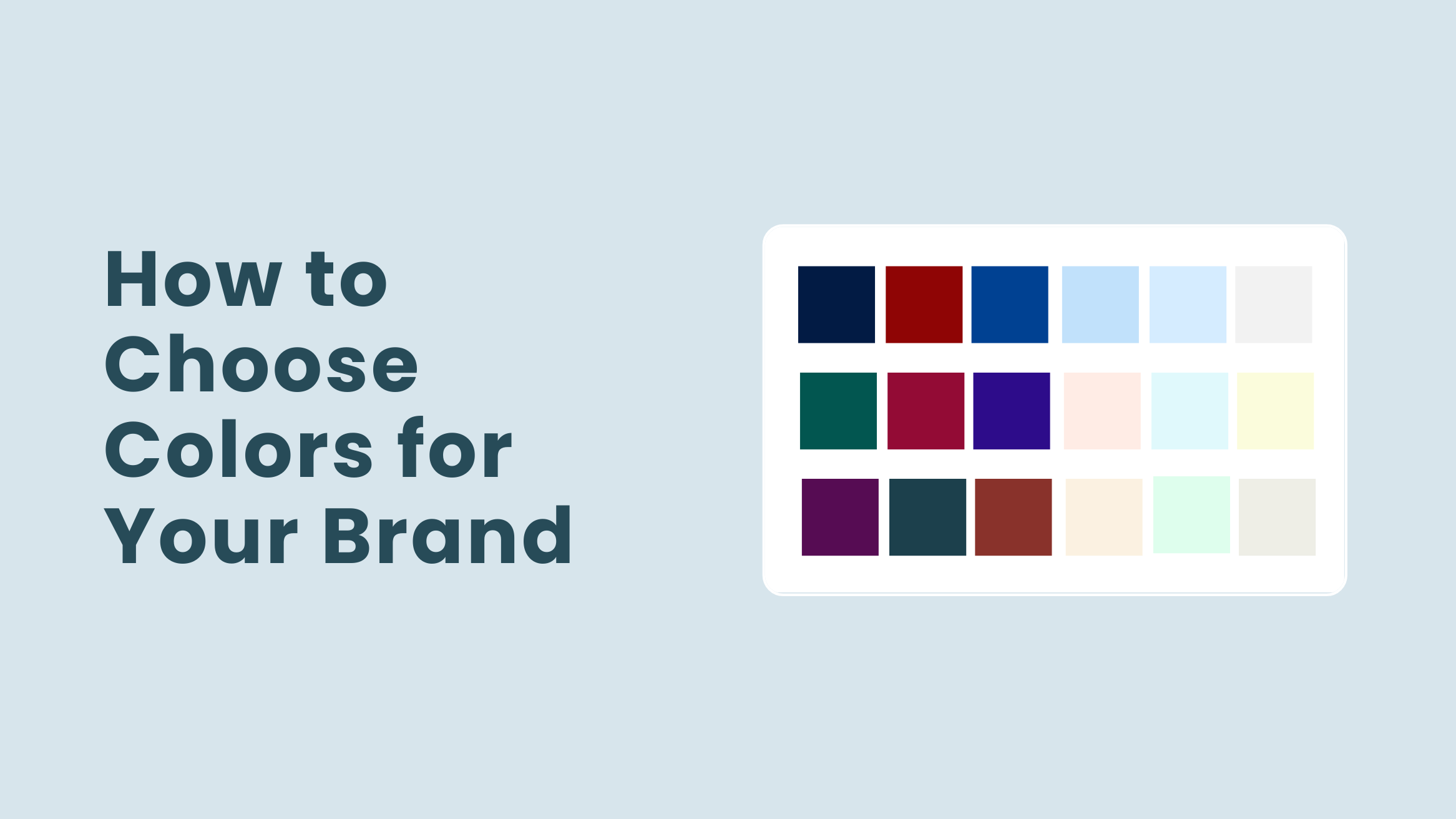
Brand Colors: How to Choose Colors for Your Brand

Choosing brand colors is one of the most important elements of your brand identity. You will never see an established brand without its own brand colors. Colors play an essential role in how your target audience perceives your brand. Therefore, you must spend enough time selecting your brand colors.
How to Choose Colors for Your Brand
- Define Your Brand Identity: Define your brand personality, values, story, and customer’s perception of your brand.
- Consider Color Meanings: Consider colors based on their meanings and align them with your brand.
- Research Your Competitors’ Brand Colors: Look at your competitors’ colors and combine them to develop a unique brand color palette.
- Select a Primary and a Secondary Color: Every brand should use light and dark colors for harmonious effect.
- Create The Brand Color Palette: Choose 3-4 colors to create a wholesome palette.
Read further to know more about the meaning of different brand colors.
According to a study conducted by Tailorbrand, color improves brand recognition by up to 80%. So, 80% of your target audience is more likely to recognize your brand if you consistently use the same colors all over your marketing materials.
However, we know that it is challenging to settle on a single color palette for your brand with so many color options to choose from. Therefore, we have come up with this handy guide for you.
Continue reading to know how to pick colors for your brand.
Table of Contents
Importance of Choosing the Right Brand Colors
Since you are reading this, you might already have some idea about the importance of brand colors for your business. Statistics show that colors influence 85% of customers’ purchase decisions. So, colors are definitely a crucial factor to consider when branding.
Let’s dig deeper into the importance of choosing brand colors.
Show Off Brand Personality
Having a brand personality is a crucial aspect of your business. It helps you reach your target audience effectively and increase customer loyalty. Brand personality is how your customers perceive your brand and connect when their personality matches your brand.
Colors can influence your customers’ perception of your brand. Specific colors support different personalities you want to portray instead of trying to align with stereotypical color associations. Therefore, colors play a huge role in defining and demonstrating your brand personality.
Look how the different colors of these two logo templates reflect the brand personality.

Get This Template and More

Get This Template and More
Set The Mood
Specific colors can evoke different emotions in the target audience. So, you can use the psychological effects of your brand colors to create feelings in your target audience and turn them into potential customers.
For example, the color combination of Red and Blue sets the mood for the Christmas Poster template below.

Get This Template and More
Develop a Consistent Branding
Picking the right brand colors and using them in all your marketing touchpoints helps you develop a consistent brand. A consistent brand is crucial for ensuring your potential customers receive the message you want to convey.
For example, you have chosen bright color options to engage your customers with an exciting and fun tone of voice. However, if you shift to a more serious tone, your target audience will get confused and might disengage from your business.
Here are the two different Business Posters that explain the same.

Get This Template and More

Get This Template and More
Enhance Brand Awareness
Creating brand awareness is a key to standing out and staying ahead of your competitors. It helps you make your customers familiar with your products or service to choose your brand over others in the market.
For example, the soft drink brand Coca-Cola and Pepsi relies heavily on their brand awareness. How will people recognize these brands without their colors? So, choose your brand colors to enhance your brand awareness and get an edge over your competitors.

Get This Template and More
What Do Different Brand Colors mean?
Now you know the importance of choosing the right brand colors to strengthen your marketing strategy. So, before jumping into the process of choosing brand colors, let’s see what different colors stand for.
Red
Red stands for energy, heat, passion, anger, and love. Use it to give your brand a loud voice and help it stand out. This color is best for the sports, caffeine drinks, and fast cars industry.
Orange
Orange is associated with youth, creativity, and enthusiasm. You can use this color to grab attention without making your brand personality as daring as Red. An excellent choice for a brand that deals with youth and creativity.
Yellow
Yellow can communicate happiness, hope, and spontaneity. You can associate speed, fun, and low-cost attributes with your brand by using Yellow as your brand color.
Green
Associated with nature, growth, and rebirth. Eco-friendly, organic, or sustainable brands can use this color.
Blue
Blue is a serene and calming color that represents responsibility and intelligence. It is also considered the most popular color in the world. Most of the businesses in the world use Blue in their brand color palette.
Purple
Purple can be both cool and warm and therefore can combine the calm and serenity of blue with the energy and passion of Red. The color is associated with luxury, mystery, and spirituality.
Pink
Pink stands for feminity, romance, sensitivity, and tenderness. The color is inherently cute, sweet, and charming. Brands that focus on products and services for women can use this color to display their brand personality easily.
Black
Black represents elegance, sophistication, and power. It is probably the most used color in graphic design. Brands can use this color to convey a sense of luxury.
White
White stands for minimalism and simplicity. Due to its clean and straightforward nature, white can create a minimalist aesthetic in your branding.
Gray
Gray is associated with conventionality, formality, and professionalism. Its negative connotation includes conventional and lacking in emotion, while the positive side can mean dependability and politeness.
How To Pick Colors For Your Brand
Now, we have come to the most critical part. You must understand that the colors you choose are meant to appeal to your customers. Hence, go through this part carefully if you don’t want to miss a large chunk of your marketing opportunities.
Follow the steps below to pick your brand colors:
Step 1: Define Your Brand Identity
Before you jump right into choosing your brand colors or any visual brand strategy work such as choosing brand fonts, creating the logo, you need to define your brand personality.
Defining your brand personality is like seeing your brand from your ideal customer’s perspective. Put together the following things to do the same:
- The Story Behind Your Brand
- The Value You Provide To Your Customers
- Your Ideal Customer
- Your Customers Perception Of Your Brand
- The Way You Want Your Customers to Interact With Your Brand
- The Reason You Started The Company
These aspects of your brand will help you define your brand identity and choose the best color for your brand.
Step 2: Consider Color Meanings
We have already discussed the different meanings of the brand colors. Now it’s time to consider them to find some possible color for your brand.
Ask yourself the following questions:
- Is your brand local, national, or international?
- Do you already have any color in mind that suits your brand personality?
- Do you offer products or services to a specific gender?
- Which industry does your company brand fit? Technology, education, food, etc.
Once you have the answers to these questions, consider the color meaning and color psychology and pick some possible colors that suit your brand the best.
Step 3: Research Your Competitors’ Brand Colors
The colors you pick for your brand should help your business stand out from the crowd. Your products or services might often appear to your customers along with your competitors’. You might not want to look the same as your competitors.
Therefore, look at the brand colors your competitors use and combine different colors to develop a unique brand color palette.
Step 4: Select a Primary and a Secondary Color
To create a harmonious effect in the color combination, every brand should use light and dark colors. Though you can combine pure white with pure black, it would be better to try different hues like eggshell white or slate grey, depending on your brand’s appearance.
Therefore, you need to choose a primary color first and then a secondary color to create the balance. For example, Coca-Cola uses Red as their primary and white as a secondary color and still has one of the most iconic brand identity.
Step 5: Create The Brand Color Palette
Once you are done choosing your primary and secondary colors, it’s time to create the primary brand color palette that you will be using on all your marketing materials. Though you can use primary and secondary colors for all your marketing graphics design, it is better to have three to four colors.
While your brand logo might include red and white, the website might consist of yellow, black, and green as well. This is where a brand color palette comes in handy. Moreover, you need to ensure that the colors you choose work together in harmony.
You can also use color palette generator tools like Adobe Color, Coolors, Muzli Colors, Color Hunt, and many others to select a suitable colors palette that applies all the aforementioned terms. These color palette generators are also a great place to get inspiration for creating a brand color palette.
Decide Where Your Brand Colors Should Appear
You have done it! You have researched a lot, found your brand colors, and created the brand color palette. Now, it’s time to decide where you will be using these colors.
To create a consistent brand identity, make sure you include the brand colors across all your touchpoints.
Here are the places where you can use the colors:
- Logo
- Website
- Social Media
- Emails
- Advertising
- Stationery
- Events
- Packaging
- Staff Uniforms
- Instore
DocHipo can help you design stunning marketing graphics such as Posters, Flyers, Blog Banners, Email Headers, YouTube Thumbnails, and many more. So, choose your brand colors and use them in your marketing touchpoints from within the DocHipo application itself.
To Summarize…
Hopefully, the article helped you understand the importance of brand colors and how to pick yours. Your brand logo, fonts, colors, and all the other marketing elements make up the face of your brand. Therefore, you can not compromise while choosing or creating any of these elements.
However, if you need more inspiration, consider reading this article on the best color combinations.
Sign-up today and explore the magical world of DocHipo.
FAQ
What colors are best match for branding?
For your brand, you need to choose colors that appeal to your target customers. Some of the steps that help you choose your brand color(s)include defining your brand identity, seeing from your target customer’s perspective, considering color meanings, researching your competitors’ brand colors, deciding the places where your brand colors will appear etc.
How do I choose brand colors and fonts?
Your brand colors should appeal to your potential customers. For choosing your brand color(s), you need to define your brand identity, see from your target customer’s perspective, consider color psychology, research your competitors’ brand colors, and go for colors that will work great on each of your branding and marketing materials.
To choose fonts for your brand, understand your brand identity, purpose and target audience, and consider the emotions you want to evoke. Choose legible, bold and large header fonts that attract audience’s attention and highly readable and legible small fonts for body text.


